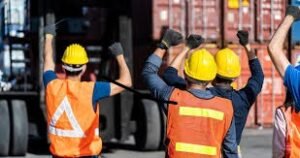
Ports are complex sound areas where various thousands of tones of shipment are transported per day. ALHWU is the union representing longshoremen and harbor workers who undertake important activities within the supply chain. These roles include:
- Cargo Handling:
Employees move goods from ship to ship, or from ships to warehouses or a transport system depending on their functions. - Equipment Operation:
Be it a crane or a forklift, expert operators of big equipment vital for today’s port operations. Training is offered by the union to see that the employees can cope with change in technological features of equipments and systems at workplaces. - Customs and Inspection Support:
Employees help in sorting goods for clearance, compliance with the requirements of the latter and the subsequent passage of the procedure. - Maintenance and Infrastructure:
Besides mere movement of cargo, these employees and particularly longshoremen as well as harbor workers also play part in maintenance of infrastructure to ensure that there is reliability of critical facilities and equipment that may be in the ports.
Challenges and Union Solutions
However, longshoremen, and harbor workers, despite their indispensability, experience a number of problems such as working with hazardous materials, working in bad weather conditions, and enduring extreme physical exertion. The ALHWU addresses these issues through:
- Collective Advocacy: The union also bargains on the wages and allowances, medical cover and even retirement issues.
- Safety Programs: ALHWU achieves this by training employees and promoting the observance of standard safety measures during the formulation of training with employers, all this result in the minimization of workplace mishaps.
- Job Security: As the world becomes more automated and globalized, the union serves an important function of guarding jobs by promoting retraining entitlements as well as equal opportunity.
The History of Longshoremen’s and Harbor Workers’ Unions
It is a fact-proven, inspiring, and triumphant tale of longshoremen’s and harbor workers’ union in the United States. The chronicle of conflict at the beginning end of the twentieth century from industrial revolutions and formation up to the contemporary development of the American Longshoremen’s and Harbor Workers’ Union is a representation of the struggle of workers’ establishment in one of the most labor-intensive professions.
Early Labor Movements in the Maritime Industry
The period from the end of the nineteenth century to World War One was a time of industrial growth in America and ports were a focus of commerce. Yet, for the longshoremen and the harbor workers, this period was marked by poor working conditions and appallingly wages. Workers often endured:
- Grueling Hours: Worked through the night caused by shifts exceeding 12 hours with no provision of extra money.
- Unsafe Conditions: Lack of safety measures at the workplace constantly caused accidents and fatalities.
- Minimal Wages: Wages remained low, and more often than not could not sustain a family.
- Job Insecurity: Temporary employment or as known as shape-up hiring, reduced employees to merely a means of getting hired on daily bases with no guarantee of employment at all.
In response to these challenges, the workers came together with intent of forming some sort of a union. It is important to note that the first signs of the labor movements started in key cities that had seaports such as New York, San Francisco and New Orleans. Organizations that campaigned for higher wages, eight-hour work and decent treatment of workers came into existance. Despite it, these initial attempts did not meet much resistance; employers still recruited scabs, hired police forces, and took advantage of the legal technicalities which nonetheless built the ground for future collective action.